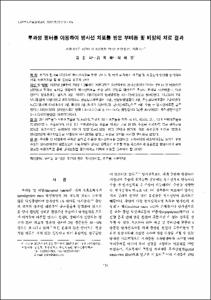KUMEL Repository
1. Journal Papers (연구논문)
1. School of Medicine (의과대학)
Dept. of Radiation Oncology (방사선종양학)
투과성 필터를 이용하여 방사선 치료를 받은 부비동 및 비암의 치료 결과
- Keimyung Author(s)
- Kim, Ok Bae; Kim, Jin Hee; Choi, Tae Jin
- Journal Title
- Radiation Oncology Journal
- Issued Date
- 2007
- Volume
- 25
- Issue
- 2
- Abstract
- Purpose : This study was to evaluate the survival and pattern of failure after radiation therapy of sino-nasal cancer using partial attenuation filer and wedged beams and to help radiotherapy planning of sino-nasal cancer.
Materials and Methods : Between February 1992 and March 2003, 17 patients with sino-nasal cancers underwent radiation therapy using partial attenuation filter at Dongsan Medical Center, Keimyung university. There were 9 male and 8 female patients. Patients' age ranged from 40 to 75 years (median 59 years). There were 10 patients of maxillary sinus cancer, 7 patiens of nasal cancer. The histologic type was squamous cell carcinoma in 11, adenoid cystic carcinoma in 4 and olfactory neuroblastoma in 2. The distribution of clinical stage by the AJCC system was 3 for stage II, 7 for III and 6 for IV. The five patients were treated with radiation alone and 12 patients were treated with surgery and postoperative radiation therapy. The range of total radiation dose delivered to the primary tumor was from 44 to 76 Gy (median 60 Gy). The follow-up period ranged from 3 to 173 months with median of 78 months.
Results : The overall 2 year survival rate and disease free survival rate was 76.4%. The 5 year and 10 year survival rate were 76.4% and 45.6% and the 5 year and 10 year disease free survival rate was 70.6%. The 5 year disease free survival rate by treatment modality was 91.6% for postoperative radiation group and 20% for radiation alone group, statistical significance was found by treatment modality (p=0.006). There were no differences in survival by pathology and stage. There were local failure in 5 patients (29%) but no distant failure and no severe complication required surgical intervention.
Conclusion : Radiation therapy of sino-nasal cancer using partial attenuation filter was safe and effective. Combined modality with conservative surgery and radiation therapy was more advisable to achieve loco-regional control in sino-nasal cancer. Also we considered high precision radiation therapy with dose escalation and development of multi-modality treatment to improve local control and survival rate in advanced sino-nasal cancer.
Key word : Sino-nasal cancer, Partial attenuation filter, Radiation, Survival of failure
목적: 투과성 필터를 이용하여 방사선치료를 받은 부비동 및 비암 환자에서 생존율 및 치료실패 양상을 분석하여 향후 치료계획을 할 때 도움을 주고자 한다.
대상 및 방법: 1992년 2월부터 2002년 3월까지 계명대학교 동산의료원 방사선종양학과에서 부비동 및 비암으로 진단받고 투과성 필터를 이용하여 방사선치료를 받은 환자 17명을 대상으로 후향적 분석을 시행하였다. 대상환자의 성별분포는 남자가 9명, 여자가 8명이었으며 연령분포는 40~75세(중앙값 59세)였다. 비강암이 7명, 부비동암이 10명이었고 조직학적으로 편평상피세포암이 11명, 선양낭성암종이 4명, 후신경모세포종이 2명이었다. AJCC 병기에 따라 II기가 3명, III기가 7명, IV기가 7명이었다. 방사선치료단독은 5명, 수술 후 방사선치료를 받은 환자는 12명이었다. 방사선치료는 일회 1.8~2.0Gy로 총 44~76Gy(중앙값 60 Gy)를 조사하였다. 추적관찰기간은 3~173개월(중앙값 78개월)이었다.
결과: 2년 생존율과 무병생존율은 76.4%이었고 5년, 10년 생존율은 각각 76.4%, 45.6%, 5년, 10년 무병생존율은 70.6%이었다. 수술유무에 따른 5년 무병생존율은 수술을 시행한 군은 91.6% 수술을 시행하지 않은 환자군은 20%로 통계적으로 유의하게 차이가 있었다(p=0.006). 병리 형태나 병기에 따른 생존율의 차이는 없었다. 5명(29%)의 국소재발률을 보였으며 원격전이는 없었고 수술을 요하는 심각한 부작용은 없었다.
결론: 부비동 및 비암에서 투과성 필터를 이용한 방사선치료는 안전하고 효과적이며 국소제어율을 높이기 위해 수술과 방사선치료의 병합요법이 바람직하며 방사선 단독으로 치료할 때는 국소제어와 생존율을 향상시키기 위해 정교한 치료계획을 통해 방사선량을 증가시키고 다학제 치료를 고려해야 할 것이다.
핵심용어 : 부비동 및 비암, 투과성 필터, 방사선치료, 생존율, 재발양상
- Alternative Title
- Result of Radiation Therapy of Sino-nasal Cancers Using Partial Attenuation Filter
- Publisher
- School of Medicine
- Citation
- 김옥배 et al. (2007). 투과성 필터를 이용하여 방사선 치료를 받은 부비동 및 비암의 치료 결과. Radiation Oncology Journal, 25(2), 118–124.
- Type
- Article
- ISSN
- 2234-1900
- 파일 목록
-
-
Download
 oak-bbb-1085.pdf
기타 데이터 / 616.58 kB / Adobe PDF
oak-bbb-1085.pdf
기타 데이터 / 616.58 kB / Adobe PDF
-
Items in Repository are protected by copyright, with all rights reserved, unless otherwise indicated.